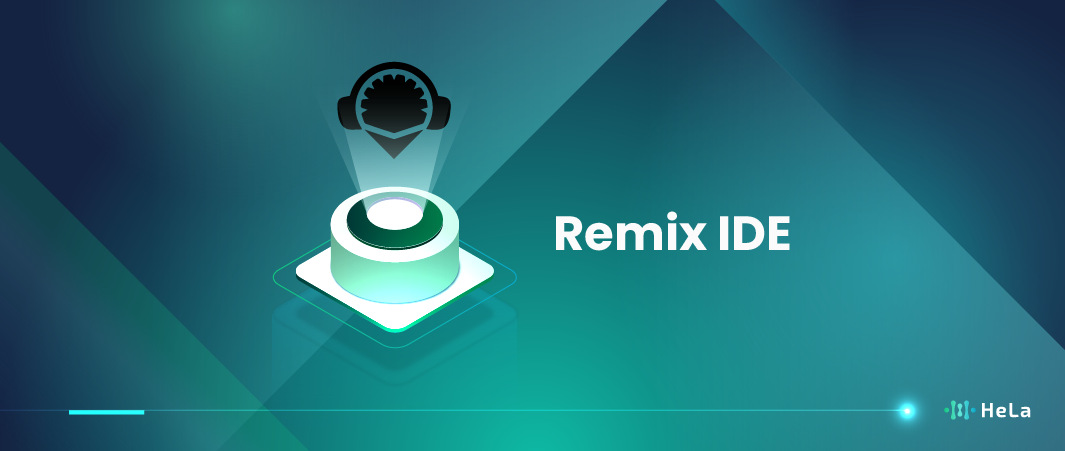When entering the rapidly evolving landscape of blockchain and Ethereum smart contract development, the tools you choose can make or break your success. Among the plethora of options available, Remix IDE stands out as a beacon for developers. What exactly is Remix IDE, and why is it so pivotal in the realm of smart contract creation and deployment?
Remix IDE is essentially a powerful, open-source tool that simplifies the process of smart contract development for the Ethereum blockchain. It is designed to cater to both newbies and seasoned developers with its user-friendly interface and robust feature set. But what makes Remix truly remarkable is its ability to seamlessly integrate various aspects of development, from writing and testing code to deploying contracts on the blockchain.
In this extensive guide, we will delve into the multifaceted world of Remix IDE. We’ll explore its core features, practical applications, and advanced techniques to help you unleash its full potential. Whether you’re taking your first steps in blockchain development or looking to refine your skills, this guide is your comprehensive manual to mastering Remix IDE.
What is Remix IDE?

Remix IDE is an integral part of the Ethereum blockchain development landscape, offering a browser-based platform for the creation, testing, and deployment of smart contracts. It is essentially a gateway that simplifies the complexities involved in blockchain development, particularly catering to those working on the Ethereum network.
The core of Remix IDE is its user-friendly interface, accessible directly through a web browser. This setup significantly lowers the barrier to entry for developers, as it removes the need for intricate local development environments. Developers can immediately start writing code, with the assurance that the tools they need are readily available and configured for Ethereum smart contract development.
The integration with Solidity is a critical aspect of Remix IDE. Solidity is the backbone of Ethereum smart contract programming, and Remix’s environment is finely tuned to complement its syntax and structure. The IDE provides advanced features like syntax highlighting, intelligent code completion, and real-time feedback on errors. This not only boosts productivity but also enhances code quality, making the development process both efficient and effective.
Also Read: 10 Top LSDFi Coins to Consider in 2024
Beyond coding, Remix IDE emphasizes the importance of testing. It comes equipped with a comprehensive suite of testing tools designed to rigorously evaluate smart contracts under various conditions. This is crucial in the blockchain domain, where contracts are immutable once deployed. The testing tools help in identifying potential issues and vulnerabilities, ensuring that the contracts are not just functional but also robust, secure, and optimized for performance.
Remix IDE serves as a multifaceted ecosystem that supports developers at every stage of Ethereum smart contract development. From coding with Solidity to testing and deployment, it provides a cohesive, user-friendly, and powerful platform that fosters innovation and efficiency in blockchain development.
Navigating the Remix IDE Interface

The Remix Integrated Development Environment (IDE) is a comprehensive and user-centric tool designed for developing smart contracts, particularly in Solidity, which is a programming language for Ethereum blockchain. The interface of Remix IDE is laid out to facilitate ease of use and efficiency in the development process. Let’s explore the key components of the interface:
File Explorer Panel
This is the organizational hub of your project. It’s where you manage your project’s files and directories. You can perform various operations like creating new files, importing existing files, and arranging your project’s structure in a systematic way. This panel makes it easy to navigate through your files, providing a clear view of your project’s hierarchy and structure.
Code Editor Panel
The heart of the Remix IDE, this panel is where you write and edit your Solidity code. The code editor is equipped with features that are essential for a smooth coding experience, such as syntax highlighting, which helps in distinguishing elements of the code through color coding, and code completion, which aids in writing code more efficiently by predicting and suggesting completions for partially typed strings. These features enhance readability and reduce the likelihood of errors, making the coding process more efficient and less error-prone.
Compile Tab
This component is crucial for validating your code. Once you’ve written or edited your code in the editor panel, you need to compile it. Compiling the code checks for errors and ensures that it’s syntactically correct and ready for deployment on the blockchain. The Remix IDE compiler is robust, providing detailed feedback on your code. It highlights errors, points out potential issues, and offers suggestions for improvement. This not only helps in fixing immediate issues but also contributes to learning and improving your coding skills over time.
Each of these components plays a vital role in the development workflow within the Remix IDE, contributing to an effective and streamlined development experience for Solidity programming and smart contract creation. The thoughtful design of the interface ensures that developers, whether beginners or experienced, can work efficiently and effectively in building blockchain-based applications.
Deploying and Testing with Remix IDE
Remix IDE significantly enhances the smart contract development process by offering a range of features that cater to various stages of a contract’s lifecycle. Here’s how it supports each critical phase:
Deployment Options
Remix IDE allows developers to deploy smart contracts on different Ethereum networks, including both testnets for testing and the mainnet for final deployment. This is crucial because it gives developers the flexibility to test their contracts under conditions that closely mimic the actual environment in which the contract will operate. By using testnets, developers can simulate real-world user interactions without incurring the costs associated with the mainnet. This setup is invaluable for identifying and rectifying issues early in the development process, ensuring the contract is fully functional and ready for production. The ability to seamlessly switch between networks within the same development environment simplifies the deployment process and ensures a smooth transition from testing to production.
Testing Tools
Testing is not an afterthought in contract development; it’s a fundamental aspect that Remix IDE robustly supports. The platform provides sophisticated tools for writing and executing tests, enabling developers to thoroughly assess every aspect of their contract. Through these tools, developers can automate testing procedures, ensuring that each function of the contract performs as expected under various conditions.
This comprehensive testing framework is essential for validating the contract’s logic, ensuring its security against potential attacks, and confirming its overall reliability. By rigorously testing the contract in a controlled environment, developers can identify and address any issues, significantly reducing the risk of costly errors or vulnerabilities in the live environment.
Gas Analysis
In the Ethereum network, every transaction and smart contract execution requires gas, and the cost of gas can vary significantly. Efficient gas usage is crucial for the practicality and financial viability of a smart contract. Remix IDE addresses this by providing detailed gas analysis tools, allowing developers to understand and optimize their contract’s gas consumption. By analyzing gas usage, developers can identify functions or parts of the contract that require excessive gas and refine their code accordingly. This not only helps in reducing the operational costs associated with the contract but also improves the overall efficiency and performance. In a competitive blockchain environment, optimizing for gas usage can significantly enhance the appeal and usability of a smart contract.
Remix IDE is an indispensable tool for smart contract developers. Its well-integrated features for deployment, testing, and gas analysis ensure that contracts are not only developed and deployed efficiently but also optimized for performance and cost-effectiveness, making it an ideal environment for creating robust, secure, and efficient smart contracts.
Advanced Features and Plugins
Remix IDE stands out as a comprehensive development environment, catering not only to the fundamental aspects of writing and testing code but also offering a plethora of advanced functionalities and extendable features through its robust plugin architecture.
One of the cornerstone features of Remix IDE is its direct interaction capability with deployed contracts. This interactive environment allows developers to not just deploy their smart contracts on the blockchain but also to actively engage with them post-deployment. Developers can invoke contract functions, monitor real-time contract activity, and analyze transaction outcomes, all within the IDE. This real-time interaction aids in thorough testing and debugging, ensuring that the contracts operate as intended in a live environment.
Beyond its core functionalities, Remix IDE fosters a vibrant and ever-expanding ecosystem of plugins. These plugins serve as modular extensions to the base IDE, each designed to augment the development experience in unique ways. From security analysis tools that scrutinize smart contracts for vulnerabilities, and code management solutions that streamline the development workflow, to plugins that facilitate seamless integration with other blockchain services and tools, the spectrum of available plugins is vast and varied.
This extensible nature of Remix IDE through plugins means that it’s not just an IDE but a versatile platform that adapts to the evolving needs of developers. Whether you’re looking to enhance your code’s security posture, manage your development lifecycle more efficiently, or integrate with other blockchain ecosystems, Remix’s plugin marketplace likely has the tools you need. This makes Remix IDE an invaluable tool for developers looking to harness the full potential of blockchain technology in their projects.
Collaborating and Sharing with Remix IDE

Remix IDE stands out as an essential tool for smart contract development, particularly due to its robust collaborative features and project management capabilities. Its integration and support for efficient workflows are especially beneficial for developers working with Ethereum smart contracts. The key features include:
Project Sharing
- Facilitates the collaboration among team members by allowing multiple developers to access, modify, and discuss the same codebase in a centralized manner, ensuring that all team members are on the same page regarding project developments.
- Enables sharing with the broader community, promoting a culture of collective improvement, peer review, and transparent development, fostering a community-driven approach to problem-solving and innovation.
- Provides tools and features like real-time editing and conflict resolution mechanisms, making it easier for teams to work together without the fear of overwriting each other’s work or losing track of the latest version.
- Offers access control mechanisms, allowing project administrators to manage who can view, edit, or contribute to the project, thereby maintaining the integrity and security of the codebase.
- Encourages knowledge sharing and continuity, as documentation and discussions about the code are centralized and accessible, making onboarding of new team members smoother and preserving the project’s intellectual capital.
Also Read: What is FaucetPay? How It Works and Why It Matters
Integration with Version Control Systems (VCS)
- Primarily integrated with GitHub, streamlining the development process by enabling efficient codebase management and collaboration, making it easier for teams to track progress and integrate changes.
- Supports best practices in software development such as tracking changes, managing contributions, and maintaining a structured, traceable history of the code, which is essential for understanding the evolution of the project and for troubleshooting issues.
- Facilitates continuous integration and continuous deployment (CI/CD) practices, allowing teams to automate testing and deployment processes, thereby reducing the chance of human error and improving the speed and reliability of releases.
- Enhances code review processes by providing tools that allow for detailed examination and discussion of proposed changes, leading to higher code quality and knowledge sharing among team members.
- Promotes a culture of accountability and transparency, as every change is tracked and attributed to an individual, making it easier to manage and understand individual contributions and responsibilities.
Alignment with Software Development Best Practices
- Ensures that the development process is not only about coding but also about maintaining an organized, accessible, and accountable codebase, which is essential for the long-term sustainability and scalability of the project.
- Enhances the development experience by encouraging the use of features like pull requests, branches, and merges, which are crucial for collaborative projects and contribute to a transparent and efficient workflow, minimizing conflicts and errors.
- Promotes adherence to coding standards and best practices, through integrated tools that provide automated code reviews, style checks, and other quality assurance mechanisms.
- Supports agile development methodologies by providing features that facilitate sprint planning, task tracking, and progress monitoring, ensuring that the team can work in a coordinated and efficient manner.
- Encourages continuous learning and improvement through integrated documentation, tutorials, and community forums, helping developers to stay updated with the latest technologies and best practices, and to continuously refine their skills and the quality of their work.
Remix IDE provides a comprehensive environment that not only supports the coding of smart contracts but also significantly enhances collaboration, project management, and adherence to best practices in software development, making it an invaluable asset in the blockchain development space.
Conclusion
Remix IDE is more than just a development environment; it’s a comprehensive platform that supports every aspect of Ethereum smart contract development. From writing and testing code to deployment and interaction, Remix provides the tools and features you need to succeed.
The platform’s intuitive interface, coupled with its powerful features and extensive plugin ecosystem, makes it an indispensable tool for both novice and experienced developers. As the blockchain landscape continues to evolve, Remix IDE stands as a reliable, versatile, and user-friendly platform that empowers developers to build the decentralized future.
Whether you’re just starting your journey in blockchain development or looking to enhance your existing projects, Remix IDE is your gateway to unlocking the full potential of Ethereum smart contract development. Embrace the power of Remix, and join the community of developers shaping the new era of decentralized applications.
Disclaimer: The information provided by HeLa Labs in this article is intended for general informational purposes and does not reflect the company’s opinion. It is not intended as investment advice or recommendations. Readers are strongly advised to conduct their own thorough research and consult with a qualified financial advisor before making any financial decisions.

Joshua Soriano
I am a writer specializing in decentralized systems, digital assets, and Web3 innovation. I develop research-driven explainers, case studies, and thought leadership that connect blockchain infrastructure, smart contract design, and tokenization models to real-world outcomes.
My work focuses on translating complex technical concepts into clear, actionable narratives for builders, businesses, and investors, highlighting transparency, security, and operational efficiency. Each piece blends primary-source research, protocol documentation, and practitioner insights to surface what matters for adoption and risk reduction, helping teams make informed decisions with precise, accessible content.
- Joshua Soriano#molongui-disabled-link
- Joshua Soriano#molongui-disabled-link
- Joshua Soriano#molongui-disabled-link
- Joshua Soriano#molongui-disabled-link

